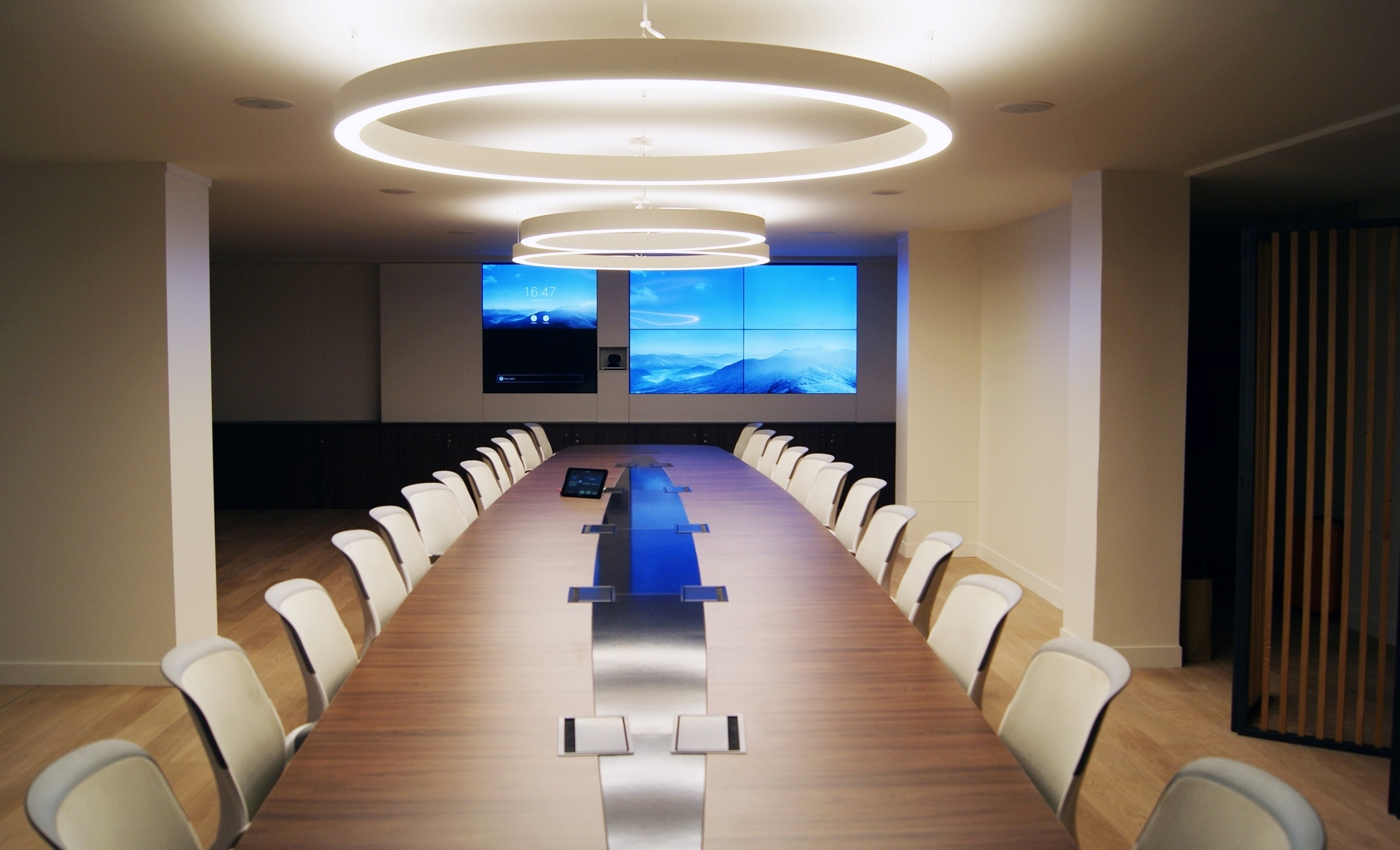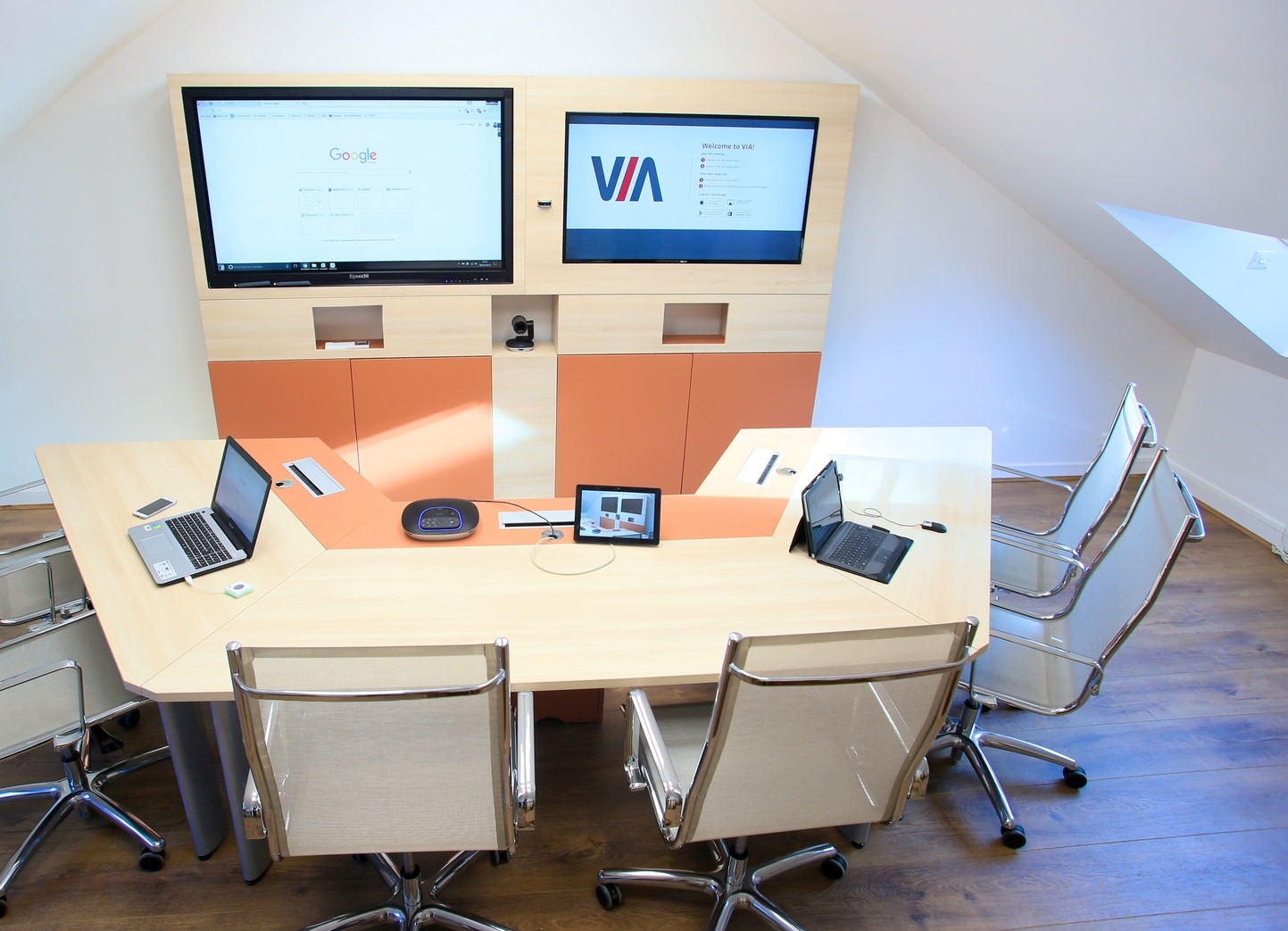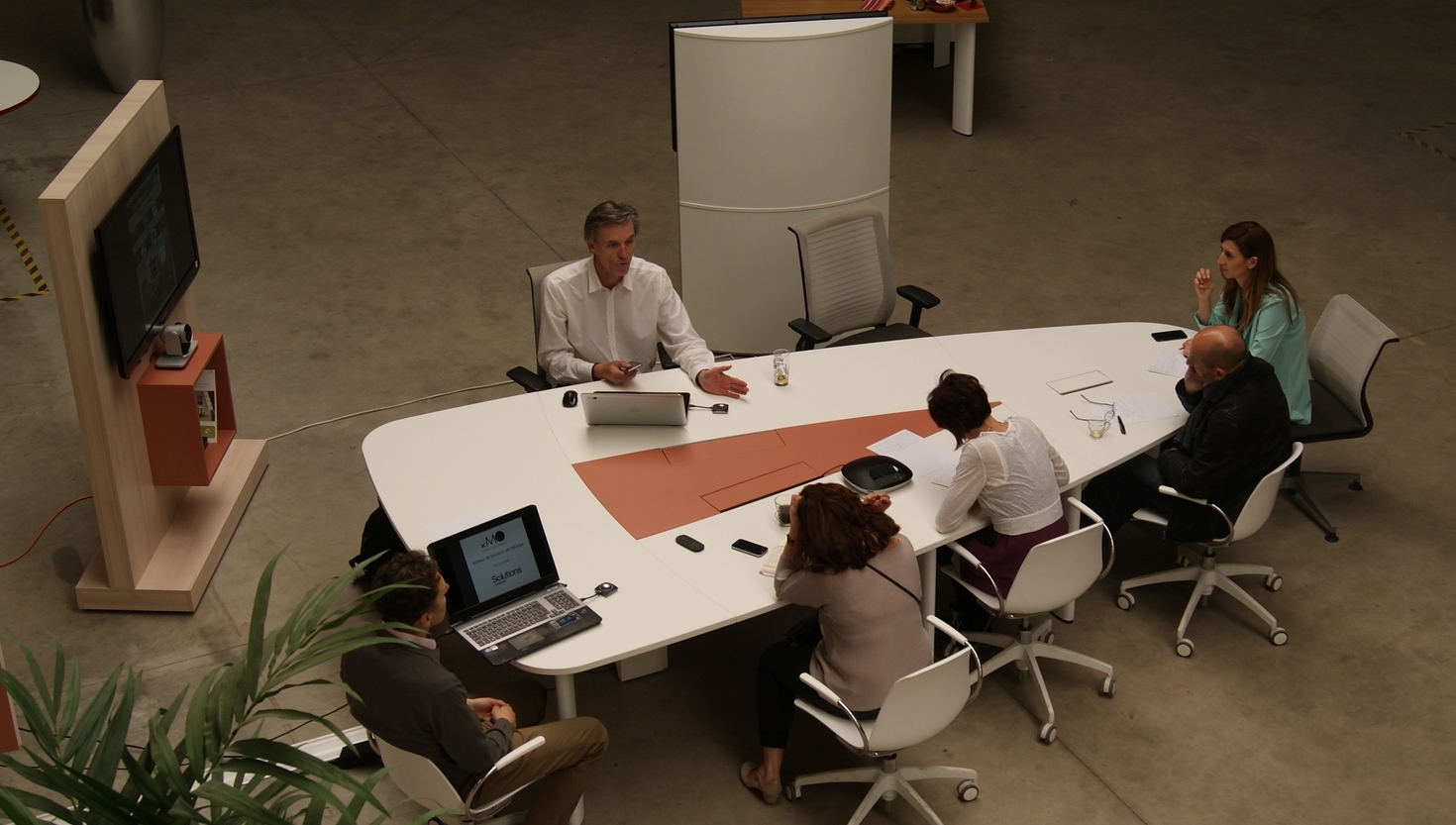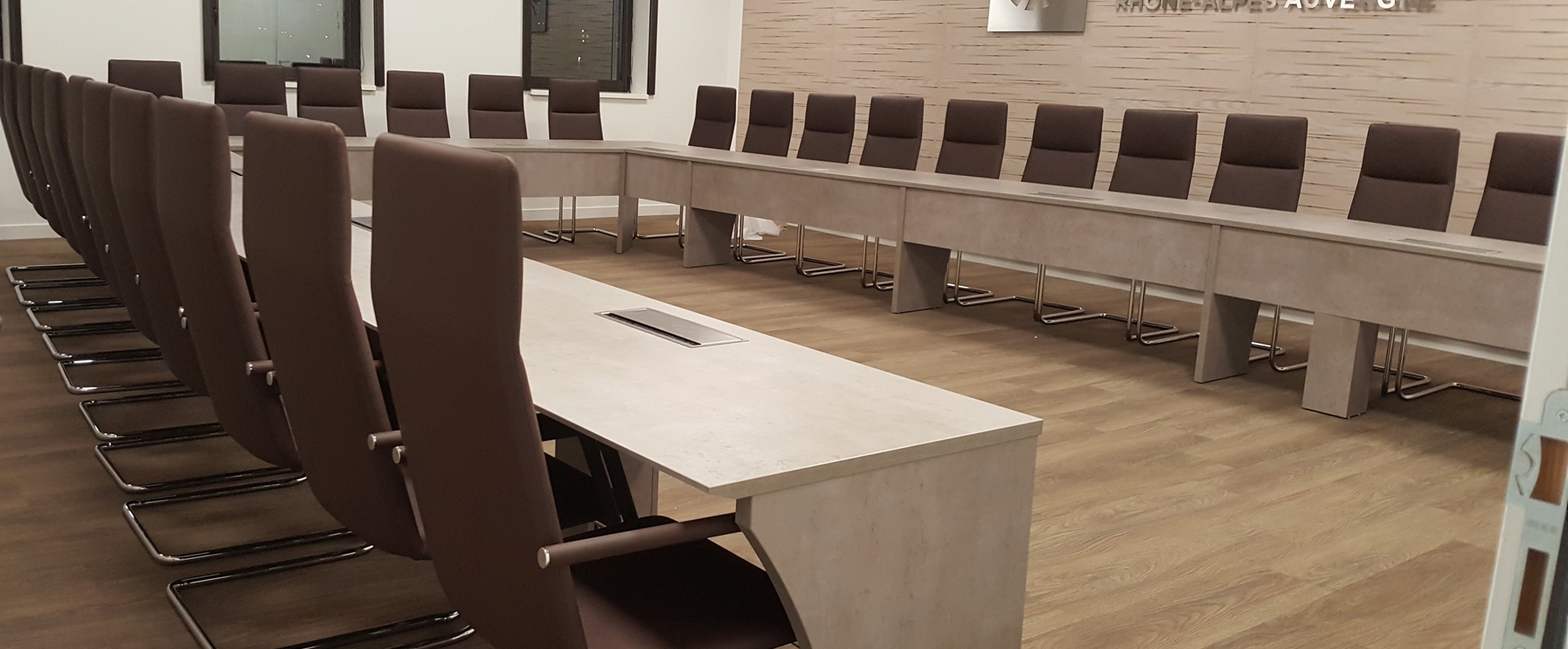
Whatever the size of your business, the meeting room is a key place where important decisions are made.
If you’re setting up a new room, planning to renovate an existing space or looking for a meeting room design idea, this article tells you everything you need to know about how to organise your team’s new favourite meeting space.
Framing the room’s objectives
There is no universal meeting room that is versatile and efficient for every use: project meeting, creativity session, formal presentation by a manager, video conference, random number of participants, etc. Doing without this framing stage may seem comfortable at first (you don’t upset anyone + saving time). However, this approach will soon come at a high price when the room is set up and operated.
To illustrate, a videoconference room does not require the same layout, furniture or technology as a creative room. In the latter, easy-to-move footstools would be an interesting solution, which should be excluded for a videoconference room.
Framing your needs and objectives is not always easy. Don’t hesitate to call on an integrator with solid experience in technology and meeting room furniture/fitting.
Key considerations for the design of the meeting room
Here’s what you need to think about when planning your meeting room layout:
- Size: Determine how many people you will need to accommodate on average in this collaborative space. Research suggests that the most productive meetings are made up of 8 people or less, so if you decide to hold smaller meetings, you may want to focus on a “huddle room” model.
- Safety: Once you have a clear head count, think about the safety features you will need. Things like wheelchair access and clear paths to emergency exit doors should be given priority.
- Space dimensions: You will also need the measurements of the space available in the room. This may seem obvious, but it is one of the first things to consider when you start to design a meeting room.
- Physiological needs: The meeting room is a place where people spend more and more time: on average, an executive spends more time in a meeting than in a room. It is therefore necessary to look closely at visual, acoustic and postural comfort aspects from the design stage.
- Technology. Essential because these are the audiovisual tools that will allow you to collaborate both in the room and remotely: screens, camera, microphone, video system, screen sharing, etc.
Decorating your meeting room
– Choice of colours
When designing meeting rooms to meet the needs of employees, colour is an often overlooked element. Psychologists and experts agree that the colour of a room has a direct impact on the mood and productivity levels of those in it.
Studies have shown that bland colours such as whites, greys and beiges induce feelings of sadness and depression in workers who are usually stuck indoors all day with fluorescent lighting.
Calm colours, such as shades of blue and green, promote productivity, concentration and relaxation. These palettes are most commonly found in nature and promote an overall sense of well-being.
Cheerful yellows, combined with optimism, are said to stimulate creativity and innovation. It’s a great choice for the creative people in your office.
Other bright colours, such as shades of red, have been shown to increase the heart rate and invoke passion. It is a good choice that, used sparingly and in small touches, can draw attention to important areas of the space.
– Materials
As well as colour, materials can change the way a space is experienced. Glass and chrome, for example, give a modern, clean look. On the other hand, wood is extremely versatile and can be used in many applications.
A well-chosen wood species can bring warmth to the room and add a sophisticated or rustic touch.
– Let natural light in
Natural lighting makes rooms feel larger while filling them with warm light. Don’t lock your team members in a dark cave and then expect them to think up big, bright new ideas.
Layout of your meeting space
When it comes to layout, there are many options. You don’t have to stick to the traditional conference room setting: a large table surrounded by chairs. In fact, you can even keep the space flexible.
Before we get to the furniture, let’s look at some of the configurations you can consider:
- U-shaped or V-shaped: This is used for meetings with a strong focus on the screen (presentations, video conferencing). This type of arrangement also allows the speaker to move around the room easily and interact with everyone. You will also see more group participation with this style.
- Classroom: This is a very popular configuration and is often used for workshops. It is ideal for training and people who will be using their laptops and other electronic devices during the meeting to take notes.
- Theatre: as the name suggests, this is similar to the setup you would find in a theatre or cinema. Here, the seats are arranged in rows, allowing the space to easily accommodate more seats. This style is often used for conferences, seminars, etc. where the participants are mainly listening.
Furniture and equipment
Next, you will need to choose the furniture for your meeting space. If your room is going to be used in different ways, you will want it to be mobile and flexible. In this way, you can set up the room in one of the different arrangements we looked at in the previous section.
· Choice of tables
The short tables can be assembled into one long table or placed in different positions, depending on the configuration you choose. This makes your space more flexible and user-friendly. Look for tables that fold easily and are easy to move.
· Choice of meeting chairs
No one wants to sit in an uncomfortable chair during a meeting, long or short. Choosing comfortable and durable seating will help everyone stay focused and productive. Consider ergonomic chairs that can be adjusted to fit everyone for maximum comfort. People likely to use the meeting room come in all shapes and sizes, so adjustable chairs are a way to keep everyone comfortable.
Another tip for choosing meeting room furniture in the COVID-19 era is to consider the materials. Avoid soft fabrics in favour of surfaces that are easy to disinfect, such as vinyl or recycled plastic.
When it comes to equipment, think again about how your room will be used. You may need equipment for virtual meetings, a screen for presentations, wireless network access and more. And don’t forget that you will need to provide excellent Internet connectivity to your meeting room. This is a necessity in a time when all participants are likely to download video content.
You may also want to include one or two sofas in the room, as well as a coffee table or side tables. This gives the room a cosy atmosphere and additional seating, if required.
Finally, don’t forget to de-clutter the room and plan the directions of movement in the space.
Choosing the tools
As with the furniture, the tools will differ depending on your objectives. However, whatever the purpose of the room, you can examine the technological equipment needed by scanning these four main features:
- Multimedia. How many screens are needed? Interactive or passive touch screens? Does the size of the room require a sound system?
- Local collaboration. What type of content sharing? How many participants can take control?
- Remote collaboration. There are many solutions: audio or video conferencing, shared interactive whiteboard, etc.
And finally, do not forget the connection between the different equipment in the room, but also with the participants. In concrete terms, you need to examine the wifi terminal(s) required, as well as the network access points (RJ45 sockets).
Examples of meeting room projects
We have selected a few examples of our work for you to use as inspiration for your design project:
Final tips on setting up your next meeting room
At the heart of any meeting room is the collaboration that takes place within it. By finding the right combination of furniture, equipment and tools for your business, you can create an environment that naturally facilitates interaction.
Also, remember that personal preferences exist in any meeting space! Crowdsource ideas and suggestions from your team so that all voices are heard and represented throughout the process of designing your new room.
Do you want to fit out your meeting room? Contact our experts for a personalised quote.
Passionate about crafting workspaces that ignite collaboration, innovation, and productivity?
Download our free Ebook :










![[Product sheet] The Nureva HDL 410](https://motilde.com/wp-content/uploads/bfi_thumb/dummy-transparent-qmghyrjdh2fhnuqum3tw5qjy0hxor65n6sjg4066wy.png)

